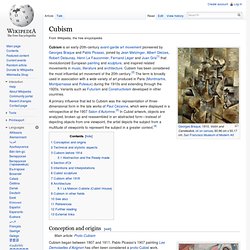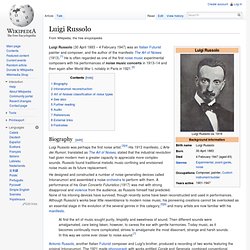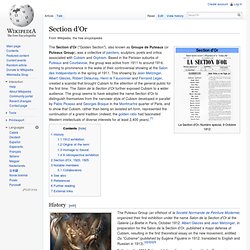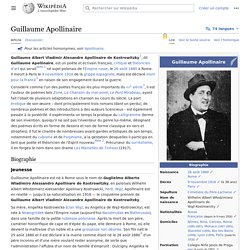

Cubisme. A primary influence that led to Cubism was the representation of three-dimensional form in the late works of Paul Cézanne, which were displayed in a retrospective at the 1907 Salon d'Automne.[3] In Cubist artwork, objects are analyzed, broken up and reassembled in an abstracted form—instead of depicting objects from one viewpoint, the artist depicts the subject from a multitude of viewpoints to represent the subject in a greater context.[4] Conception and origins[edit] Pablo Picasso, 1909-10, Figure dans un Fauteuil (Seated Nude, Femme nue assise), oil on canvas, 92.1 x 73 cm, Tate Modern, London Cubism began between 1907 and 1911.

Pablo Picasso's 1907 painting Les Demoiselles d'Avignon has often been considered a proto-Cubist work. Georges Braque's 1908 Houses at L’Estaque (and related works) prompted the critic Louis Vauxcelles to refer to bizarreries cubiques (cubic oddities). John Berger identifies the essence of Cubism with the mechanical diagram. "M. Futurism. Gino Severini, 1912, Dynamic Hieroglyphic of the Bal Tabarin, oil on canvas with sequins, 161.6 x 156.2 cm (63.6 x 61.5 in.), Museum of Modern Art, New York §Italian Futurism[edit] Futurism is an avant-garde movement founded in Milan in 1909 by the Italian poet Filippo Tommaso Marinetti.[1] Marinetti launched the movement in his Futurist Manifesto,[3] which he published for the first time on 5 February 1909 in La gazzetta dell'Emilia, an article then reproduced in the French daily newspaper Le Figaro on Saturday 20 February 1909.[4][5] He was soon joined by the painters Umberto Boccioni, Carlo Carrà, Giacomo Balla, Gino Severini and the composer Luigi Russolo.

Marinetti expressed a passionate loathing of everything old, especially political and artistic tradition. "We want no part of it, the past", he wrote, "we the young and strong Futurists! " The Futurist painters were slow to develop a distinctive style and subject matter. They often painted modern urban scenes. Giacomo Balla. Carlo Carrà. Biography[edit] Carrà was born in Quargnento, near Alessandria (Piedmont).

At the age of 12 he left home in order to work as a mural decorator. The Funeral of the Anarchist Galli. Carrà's Futurist phase ended around the time World War I began. Umberto Boccioni. Umberto Boccioni (Italian pronunciation: [umˈbɛrto botˈtʃoːni]; 19 October 1882 – 17 August 1916) was an influential Italian painter and sculptor.

He helped shape the revolutionary aesthetic of the Futurism movement as one of its principal figures. Despite his short life, his approach to the dynamism of form and the deconstruction of solid mass guided artists long after his death.[1] His works are held by many public art museums, and in 1988 the Museum of Modern Art in New York organized a major retrospective of 100 pieces.[2] Biography[edit] Umberto Boccioni was born on 19 October 1882 in Reggio Calabria, the southernmost tip of mainland Italy. His father was a minor government employee, originally from the Romagna region in the north, and his job included frequent reassignments throughout Italy. Tableaux d'Umberto Boccioni. Éternels Éclairs.

Luigi Russolo. Biography[edit] Luigi Russolo was perhaps the first noise artist.[3][4] His 1913 manifesto, L'Arte dei Rumori, translated as The Art of Noises, stated that the industrial revolution had given modern men a greater capacity to appreciate more complex sounds.

Russolo found traditional melodic music confining and envisioned noise music as its future replacement. He designed and constructed a number of noise-generating devices called Intonarumori and assembled a noise orchestra to perform with them. A performance of his Gran Concerto Futuristico (1917) was met with strong disapproval and violence from the audience, as Russolo himself had predicted.
Albert Gleizes. Albert Gleizes (8 December 1881 – 23 June 1953), was a French artist, theoretician, philosopher, a self-proclaimed founder of Cubism and an influence on the School of Paris.

Albert Gleizes and Jean Metzinger wrote the first major treatise on Cubism, Du "Cubisme", 1912. Gleizes was a founding member of the Section d'Or group of artists. Jean Metzinger. Un article de Wikipédia, l'encyclopédie libre.

Jean Metzinger Jean Metzinger circa 1912 Œuvres réputées Portrait de Jean Metzinger dit L'Homme à la tulipe (1906) par Robert Delaunay, localisation inconnue. Section d'Or. History[edit] The Puteaux Group (an offshoot of la Société Normande de Peinture Moderne) organized their first exhibition under the name Salon de la Section d'Or at the Galerie La Boétie in Paris, October 1912.

Albert Gleizes and Jean Metzinger, in preparation for the Salon de la Section d'Or, published a major defense of Cubism, resulting in the first theoretical essay on the new movement, entitled Du "Cubisme" (published by Eugène Figuière in 1912, translated to English and Russian in 1913).[2][3][4][5] 1912 exhibition[edit] The 1912 Salon de la Section d'Or was arguably the most important pre-World War I Cubist exhibition. In the previous year the Cubists and a large number of their associates had exhibited at the Galerie de l'Art Contemporain (rue Tronchet, Paris) under the auspices of the Société Normande de Peinture Moderne. Origins of the term[edit] The idea of the Section d'Or originated in the course of conversations between Gleizes, Metzinger and Jacques Villon. Guillaume Apollinaire. Guillaume Apollinaire en 1916. signature.

Louis Marcoussis. Louis Marcoussis, formerly Ludwik Kazimierz Wladyslaw Markus or Ludwig Casimir Ladislas Markus, (1878 or 1883,[1] Łódź – October 22, 1941, Cusset) was a painter and engraver of Polish origin who lived in Paris for much of his life and became a French citizen. After studying law briefly in Warsaw he went to the Kraków Academy of Fine Arts, where his teachers included Jan Stanislawski and Jozev Mehoffer. Moving to Paris in 1903, he spent a short time at the Académie Julian under Jules Lefebvre. The first time a painting of his was shown in a major exhibition was at the Salon d'Automne in 1905, and over the next quarter-century his work was shown in many other important exhibitions, in particular at the Salon des Indépendants and the Salon des Tuileries.
Fernand Léger. Joseph Fernand Henri Léger (French: [leʒe]; February 4, 1881 – August 17, 1955) was a French painter, sculptor, and filmmaker. In his early works he created a personal form of cubism which he gradually modified into a more figurative, populist style. His boldly simplified treatment of modern subject matter has caused him to be regarded as a forerunner of pop art. Juan Gris. José Victoriano (Carmelo Carlos) González-Pérez (March 23, 1887 – May 11, 1927), better known as Juan Gris (Spanish pronunciation: [ˈxwaŋ ˈɡɾis]), was a Spanish painter and sculptor born in Madrid who lived and worked in France most of his life. Closely connected to the innovative artistic genre Cubism, his works are among the movement's most distinctive.
Early life[edit] Born in Madrid, Gris studied mechanical drawing at the Escuela de Artes y Manufacturas in Madrid from 1902 to 1904, during which time he contributed drawings to local periodicals. From 1904 to 1905, he studied painting with the academic artist José Moreno Carbonero. It was in 1905 that José González adopted the more distinctive name Juan Gris.[1] Pablo Picasso. Picasso, Henri Matisse and Marcel Duchamp are regarded as the three artists who most defined the revolutionary developments in the plastic arts in the opening decades of the 20th century, responsible for significant developments in painting, sculpture, printmaking and ceramics.[4][5][6][7] Picasso demonstrated extraordinary artistic talent in his early years, painting in a realistic manner through his childhood and adolescence.
During the first decade of the 20th century, his style changed as he experimented with different theories, techniques, and ideas. His work is often categorised into periods. While the names of many of his later periods are debated, the most commonly accepted periods in his work are the Blue Period (1901–1904), the Rose Period (1904–1906), the African-influenced Period (1907–1909), Analytic Cubism (1909–1912), and Synthetic Cubism (1912–1919). Early life. Tableaux de Pablo Picasso. Éternels Éclairs La Biographie Il est recommandé d'aller voir le site officiel. - Aussi : Des droits d'auteurs protègent les oeuvres ici présentes ; en cas de réclamation des ayants droit celles-ci seraient immédiatement retirées.
Stéphen Moysan. Georges Braque. Georges Braque (French: [bʁak]; 13 May 1882 – 31 August 1963) was a major 20th-century French painter, collagist, draughtsman, printmaker and sculptor. His most important contributions to the history of art were in his alliance with Fauvism from 1906, and the role he played in the development of Cubism. Braque’s work between 1908 and 1912 is closely associated with that of his colleague Pablo Picasso. Their respective Cubist works were indistinguishable for many years, yet the quiet nature of Braque was partially eclipsed by the fame and notoriety of Picasso.[1] Fauvism. Artists and style[edit] Press clipping, Les Fauves: Exhibition at the Salon d'Automne, in L'Illustration, 4 November 1905 Besides Matisse and Derain, other artists included Albert Marquet, Charles Camoin, Louis Valtat, the Belgian painter Henri Evenepoel, Maurice Marinot, Jean Puy, Maurice de Vlaminck, Henri Manguin, Raoul Dufy, Othon Friesz, Georges Rouault, Jean Metzinger, the Dutch painter Kees van Dongen and Georges Braque (subsequently Picasso's partner in Cubism).[1] The paintings of the Fauves were characterized by seemingly wild brush work and strident colors, while their subject matter had a high degree of simplification and abstraction.[3] Fauvism can be classified as an extreme development of Van Gogh's Post-Impressionism fused with the pointillism of Seurat[3] and other Neo-Impressionist painters, in particular Paul Signac.
Fauvism can also be seen as a mode of Expressionism.[3] Henri Matisse. André Derain. Francis Picabia. Francis Picabia (French: [fʁɑ̃sis pikabja]; born Francis-Marie Martinez de Picabia, 22 January 1879 – 30 November 1953) was a French avant-garde painter, poet and typographist. Tableaux de Francis Picabia. Éternels Éclairs La Biographie Il est recommandé d'aller voir le site officiel. - Aussi : Des droits d'auteurs protègent les oeuvres ici présentes ; en cas de réclamation des ayants droit celles-ci seraient immédiatement retirées. Stéphen Moysan.